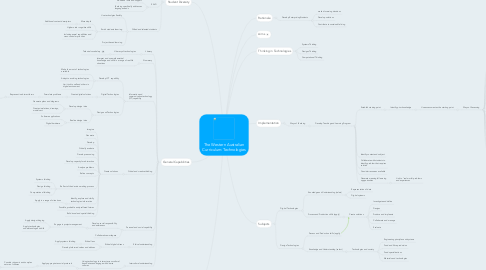
1. Rationale
1.1. Develop Enterprising Students
1.1.1. make discerning desicions
1.1.2. Develop solutions
1.1.3. Contribute to sustainable living
2. Aims
3. Thinking in Technologies
3.1. Systems Thinking
3.2. Designs Thinking
3.3. Computational Thinking
4. Student Diversity
4.1. Students with disability
4.1.1. Adjustments to teaching
4.1.2. Adjustments to how learning is demobstrated
4.1.3. Adjustments to curriculum
4.1.3.1. Draw from content at different levels
4.1.4. Adjustments to delivery of practical aspects
4.1.4.1. Modified tools, material or equipment
4.1.5. Adjustment of assessment
4.2. EALD
4.2.1. Additional time and support
4.2.2. Teaching specifically addresses language needs
4.3. Gifted and talented students
4.3.1. Use technolgies flexibly
4.3.2. Enrich students leanring
4.3.2.1. More depth
4.3.2.1.1. Additional content descriptors
4.3.2.2. Higher order cognitive skills
4.3.2.3. Include general capabilities and cross-curricular priorities
4.3.3. Project based learning
5. General Capabilities
5.1. Literacy
5.1.1. Lliteracy of technologies
5.1.1.1. Technical vocabulary
5.2. Numeracy
5.2.1. Interpret and use mathematical knowledge and skills in a range of real-life situations
5.3. Information and communication technology (ICT) capability
5.3.1. Develop ICT capability
5.3.1.1. Make the most of technologies available
5.3.1.2. Adapt to evolving technologies
5.3.1.3. Limit risk to self and others in digital environment
5.3.2. Digital Technologies
5.3.2.1. Create digital solutions
5.3.2.1.1. Formulate problems
5.3.3. Design and Technologies
5.3.3.1. Develop design idea
5.3.3.1.1. Generate plans and diagrams
5.3.3.1.2. Create simulations, drawings, models ect
5.3.3.2. Realise design idea
5.3.3.2.1. Software applications
5.3.3.2.2. Digital hardware
5.4. Critical and creative thinking
5.4.1. Create solutions
5.4.1.1. Imagine
5.4.1.2. Generate
5.4.1.3. Develop
5.4.1.4. Critically evaluate
5.4.1.5. Develop reasoning
5.4.1.6. Develop capacity for abstraction
5.4.1.7. Analyse problems
5.4.1.8. Refine concepts
5.4.1.9. Reflect of the decision-making process
5.4.1.9.1. Systems thinking
5.4.1.9.2. Design thinking
5.4.1.9.3. Computational thinking
5.4.1.10. Identify, explore and clarify technologies information
5.4.1.10.1. Apply in a range of situations
5.4.1.11. Possible, probable and preffered futures
5.4.1.12. Build visual and spatial thinking
5.5. Personal and social capability
5.5.1. Develop social responsibility and awareness
5.5.1.1. Engage in project management
5.5.1.1.1. Apply design thinging
5.5.1.1.2. Apply technologies understanding and skills
5.5.2. Collaborative workspace
5.6. Ethical understanding
5.6.1. Ethical digital citizens
5.6.1.1. Ethical lens
5.6.1.1.1. Apply systems thinking
5.6.1.2. Develop Informed values and attitues
5.7. Intercultural understanding
5.7.1. Using technology to interact across cultural boundaries and engage with diverse cultures
5.7.1.1. Apply appropriate social protocols
5.7.1.1.1. Consider dynamic and complex nature of cultures
6. Cross-Curriculum Priorites
6.1. Aboriginal and Torres Strait Islander histories and cultures
6.1.1. Value and appreciate the contribution by the world's oldest continuous living cultures to past, present and emerging technologies
6.1.1.1. Explore capacity for innovation
6.2. Asia and Australia's engagement with Asia
6.2.1. Provides diverse and authentic contexts to develop knowledge and understanding of technologies processes and production
6.2.1.1. Continued need for creative solutions
6.3. Sustainability
6.3.1. Anticipating and balancing economic, environmental and social impacts
6.3.1.1. Creating preferred futures
7. Implementation
7.1. Ways of Teaching
7.1.1. Develop Teaching and Learning Program
7.1.1.1. Establish starting point
7.1.1.1.1. Identify prior knowledge
7.1.1.2. Identify context and subject
7.1.1.3. Collaborate with students to identify problem that requires solution
7.1.1.4. Consider resources available
7.1.1.5. Generate meaningful learning oppportunities
7.1.1.5.1. Link to "real world: problems and experiences
8. Subjects
8.1. Digital Technologies
8.1.1. Knowledge and Understanding (select)
8.1.1.1. Representation of data
8.1.1.2. Digital systems
8.1.2. Process and Production skills (apply)
8.1.2.1. Create solutions
8.1.2.1.1. Investigate and define
8.1.2.1.2. Designs
8.1.2.1.3. Produce and impleents
8.1.2.1.4. Collaborate and manage
8.1.2.1.5. Evaluate
8.2. Design Technologies
8.2.1. Process and Production skills (apply)
8.2.2. Knowledge and Understanding (select)
8.2.2.1. Technologies and society
8.2.2.1.1. Engineering principles and systems
8.2.2.1.2. Food and fibre production
8.2.2.1.3. Food specialisations
8.2.2.1.4. Materials and technologies
